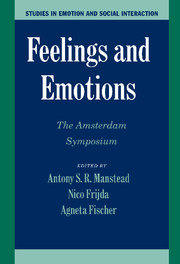Book contents
- Frontmatter
- Contents
- List of Contributors
- 1 Introduction
- PART I THE NATURE OF FEELINGS AND EMOTIONS
- PART II BASIC PSYCHOLOGICAL PROCESSES IN FEELINGS AND EMOTIONS
- 8 What We Become Emotional About
- 9 Feelings Integrate the Central Representation of Appraisal-driven Response Organization in Emotion
- 10 Emotions and Action
- 11 Basic Affects and the Instinctual Emotional Systems of the Brain
- 12 Exposure Effects
- 13 Feeling States in Emotion
- PART III FEELINGS AND EMOTIONS: THE PLACE OF PLEASURE
- PART IV FEELINGS AND EMOTIONS IN THEIR SOCIOCULTURAL CONTEXT
- PART V FEELINGS, EMOTIONS, AND MORALITY
- Subject Index
- Author Index
- Plate section
- References
10 - Emotions and Action
Published online by Cambridge University Press: 05 June 2012
- Frontmatter
- Contents
- List of Contributors
- 1 Introduction
- PART I THE NATURE OF FEELINGS AND EMOTIONS
- PART II BASIC PSYCHOLOGICAL PROCESSES IN FEELINGS AND EMOTIONS
- 8 What We Become Emotional About
- 9 Feelings Integrate the Central Representation of Appraisal-driven Response Organization in Emotion
- 10 Emotions and Action
- 11 Basic Affects and the Instinctual Emotional Systems of the Brain
- 12 Exposure Effects
- 13 Feeling States in Emotion
- PART III FEELINGS AND EMOTIONS: THE PLACE OF PLEASURE
- PART IV FEELINGS AND EMOTIONS IN THEIR SOCIOCULTURAL CONTEXT
- PART V FEELINGS, EMOTIONS, AND MORALITY
- Subject Index
- Author Index
- Plate section
- References
Summary
ABSTRACT
This chapter discusses the relationships between emotion and action. Emotion, by its very nature, is change in action readiness to maintain or change one's relationship to an object or event. Motivation, or motivational change, is one of the key aspects of emotions.
Even so, action follows only under certain conditions, including the presence and availability of an action repertoire, an equilibrium of the costs and benefits of action, and the presence of resources and motivation to consider the costs and benefits.
There are trade-offs between selection from the repertoire and the cost-benefit aspects. The repertoire usually includes low-effort actions that considerably expand the influence of emotions on action.
Obviously, emotions have very much to do with action. One would say that emotions exist for the sake of action, for dealing with the environment. Yet, the relationship between emotion and action is variable. There is much emotion without action; there is also much action without obvious emotion. How to understand the relationships?
In this chapter, I shall do two things. First, I argue that motivation for action – changes in motivation, and motivational processes – is part and parcel of what we mean by emotions. Little theory exists, however, to account for it. Second, I explore the conditions under which those motivations do and do not actually lead to action.
- Type
- Chapter
- Information
- Feelings and EmotionsThe Amsterdam Symposium, pp. 158 - 173Publisher: Cambridge University PressPrint publication year: 2004
References
- 126
- Cited by

